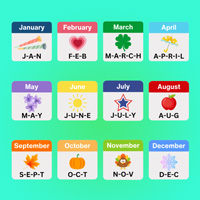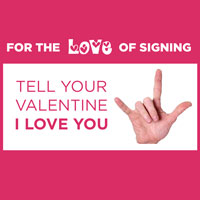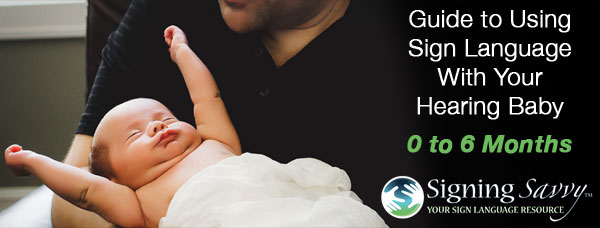
Guide to Using Sign Language With Your Hearing Baby: 0 to 6 Months
It’s easy to start signing with your baby and it’s amazing to be able to communicate with them through sign before they are able to talk. To get started, simply use signs when communicating with your child. There isn’t a "right" way or specific order to learning or teaching signs, just start by picking signs that make the most sense in the context of your baby’s life. There is no limit to how many signs you should introduce at a time, so sign as much as you are comfortable with. In particular, fluent signers and parents with deaf children should sign as much as possible.
This is just one example of how you could introduce signs to a baby that is 0 to 6 months old and comes from the prospective of hearing parents with hearing children.
Who lives in the household and who do they interact with the most?
When we had our first son, our household included my husband and I and our new son, so we signed MOM and DAD to him. Now we have a new baby boy, so we also sign BABY and BROTHER.
If you have others that interact with your baby on a regular basis, you can also sign their names, such as GRANDPA, GRANDMA, AUNT, UNCLE, etc. Our family doesn’t live in the same city as us, so we mostly stuck to signing just MOM and DAD. We would sign in context to when we were talking about that person or when they were in the room. For example, "DAD is on his way home." "Look, DAD is home!"
When we would call family, we would use the sign then as well. For example, we would say, "We’re going to call GRANDPA and GRANDMA now," and sign GRANDPA and GRANDMA. We would sign GRANDPA and GRANDMA again when we were on the phone with them. We would often do video calls (FaceTime or Skype) and point to them and say and sign, "That’s GRANDPA. That’s GRANDMA."
Don’t forget about your pets, they’re a part of your household too! We have a cat, so we would sign CAT when he came in the room with us.
Think about anyone that your baby interacts with on a regular or daily basis. Who watches them during the day? A parent? A family member? A BABYSITTER?
What activities do they do the most?
Think about what your baby does the most throughout the day – these are the things that are most common to your baby’s world and the best signs to start with.
Newborns do very little – mostly they eat/drink milk, sleep, and go to the bathroom.
The most common sign we would use is MILK. Every time our son would have a feeding or bottle we would sign MILK. We would say, "Are you hungry, do you want some MILK?" While feeding him, we would say and sign, "Here’s your MILK."
We would also sign SLEEP. "Are you ready to go to SLEEP?" "Have a good night SLEEP." "SLEEP tight, don’t let the bed bugs bite." "How did you SLEEP?"
Newborns also go to the bathroom… a lot! When we would change our son’s diaper, we would sign POTTY / BATHROOM. You could sign DIAPER, but I found signing DIAPER to be a little impractical because it is signed at the waist and either I was holding him or he was on the changing table, my waist would typically be below my son’s eye level and I wanted him to be able to see when I signed, so using the sign POTTY just worked better for us.
We would sign BATH – "Are you ready for your BATH?" "Time for your BATH!" "You’re taking a BATH" "Isn’t it fun to take a BATH?"
If you have a daily or nightly routine you usually follow you can incorporate signs from those activities as well. For example, if you READ BOOKS or SING lullabies.
As the baby grows and does more things during the day, you can incorporate more signs into your daily usage, like the sign PLAY.
Introduce new signs contextually, when something is happening or about to happen. For example, if you are taking your baby to daycare, start signing SCHOOL the week before daycare starts (lots of people call daycare "school," but use whatever terminology you prefer to call it). Say, "Next week you’re going to SCHOOL." "Today you’re going to SCHOOL." "This is your SCHOOL."
Fingerspelling and the Alphabet
Fingerspelling is an important part of American Sign Language. Fingerspelling is signing the individual letters of the alphabet to spell out words. If you’re not sure what the sign is for an individual English word, you should think about the meaning of the word because that may help you think of a sign has that same meaning, however, there are many English words that do not have an ASL sign and should be fingerspelled. Names are often fingerspelled, such as the name of a company or of a person that does not have a sign name.
There are a number of ways you can introduce the alphabet and fingerspelling to your child.
- Sign the Alphabet song
- Read the book Chika Chika Boom Boom and sign the letters as they are mentioned throughout the book
- Sign names – say, "Your name is ________" and fingerspell their name. You can also say, "Your name is spelled _______." You can tell them other people’s names and spell them, like siblings’ names, etc. Don't forget about your pet's names too!
While spelling is likely beyond the cognitive abilities of this age range, it never hurts to start to lay the foundation earlier and I like the excuse to practice my fingerspelling! Children do recognize the shapes that you are making and will learn what a name looks like over time and will eventually realize the sign is made up of individual letters. It’s not expected, or is it the point, that they understand individual letters at this young age, but what’s important is that introducing fingerspelling continues to enhance communication and language skills.
Again, remember these are just suggestions. There isn’t a "right" way or specific order to learning or teaching signs, just start by picking signs that make the most sense in the context of your baby’s life. And keep doing it!
More Resources to Help You Get Started
Signing Savvy Wordlist:
Printable Poster:

Signing Savvy Member Feature: Download this image / flyer as a printable PDF page.
ADVERTISEMENTS
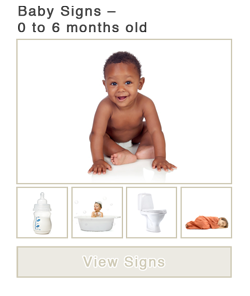
 Use Sign Language to Communicate With Your Hearing Baby Before They Can Talk – An Overview of Why to Use American Sign Language (ASL)
Use Sign Language to Communicate With Your Hearing Baby Before They Can Talk – An Overview of Why to Use American Sign Language (ASL) When and How to Start Using Sign Language With Your Hearing Baby
When and How to Start Using Sign Language With Your Hearing Baby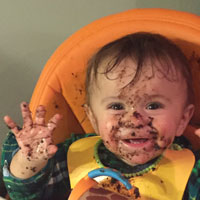 Guide to Using Sign Language With Your Hearing Baby: Signing With Food - Starting at 4 to 6 Months (whenever they start eating)
Guide to Using Sign Language With Your Hearing Baby: Signing With Food - Starting at 4 to 6 Months (whenever they start eating) The Importance of Early Exposure to American Sign Language with Deaf Children
The Importance of Early Exposure to American Sign Language with Deaf Children




